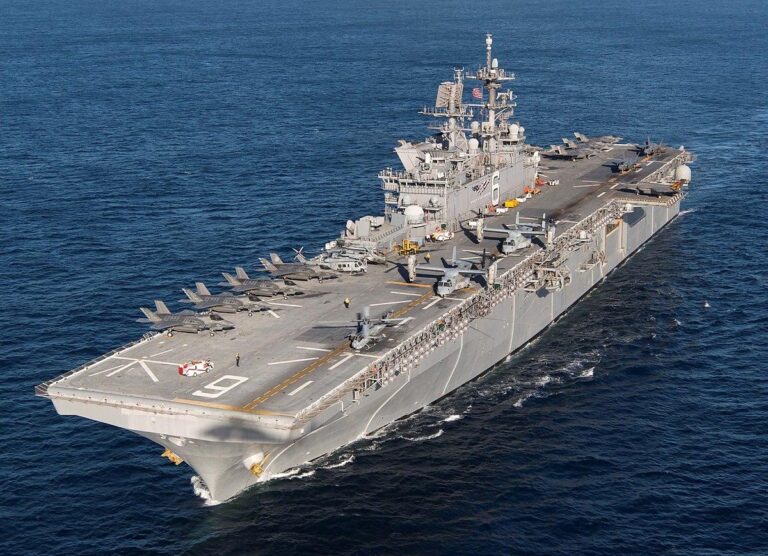Strengthening U.S. Naval Forces in the Caribbean Amid Venezuela Tensions
The United States Navy has recently intensified its maritime operations in the Caribbean Sea by deploying a combination of amphibious assault ships and guided-missile destroyers near Venezuelan territorial waters. This strategic move aims to reinforce efforts against the persistent threat of narcotics trafficking, which remains a significant challenge due to the entrenched presence of powerful drug cartels in the region. Amphibious vessels, capable of supporting a wide range of missions from humanitarian aid to rapid troop deployment, enhance the Navy’s operational flexibility and readiness to respond swiftly to emerging threats.
The deployment focuses on several critical objectives:
- Enhanced maritime interdiction: Increasing patrols to disrupt drug smuggling routes and cartel logistics.
- Collaborative training: Conducting joint exercises with regional allies to boost interoperability and intelligence exchange.
- Disaster response preparedness: Maintaining amphibious capabilities to provide humanitarian assistance in case of natural disasters.
| Ship Class | Primary Function | Operational Strengths |
|---|---|---|
| Amphibious Assault Ships | Versatile mission support | Transporting troops, helicopter deployment, humanitarian missions |
| Guided-Missile Destroyers | Surface combat and missile defense | Anti-aircraft, anti-submarine warfare, ballistic missile interception |
Naval Assets and Their Role in Counter-Narcotics Efforts
The strategic deployment of U.S. destroyers in tandem with amphibious assault ships marks a deliberate intensification of efforts to dismantle drug trafficking networks operating near Venezuela’s coastline. Destroyers are equipped with advanced radar and missile defense systems, enabling them to monitor vast maritime areas and detect suspicious vessels attempting to evade law enforcement. Amphibious ships complement this by offering rapid deployment capabilities for special operations teams, facilitating interdiction missions in complex coastal environments where cartels often exploit natural geography to their advantage. This combined force structure creates a robust, multi-layered security presence that balances maritime control with tactical agility.
The operational benefits of this integrated approach include:
- Force projection: Amphibious ships serve as mobile platforms for deploying ground forces into contested coastal zones.
- Comprehensive surveillance: Destroyers’ sensor arrays provide early detection of illicit maritime activity.
- Swift interdiction: The ability to rapidly respond to intelligence cues ensures timely disruption of trafficking operations.
| Ship Type | Core Capability | Mission Role |
|---|---|---|
| Guided-Missile Destroyer | Long-range detection and missile defense | Maritime surveillance and escort duties |
| Amphibious Assault Ship | Troop transport and amphibious operations | Rapid deployment and coastal interdiction |
Regional Security Implications of U.S. Naval Escalation Near Venezuela
The augmented presence of U.S. amphibious and destroyer-class vessels near Venezuelan shores represents a notable shift in the military dynamics of the region, intensifying the security environment for Venezuela and its neighbors. This naval buildup is part of a comprehensive strategy to disrupt entrenched criminal enterprises, particularly drug cartels that have historically leveraged Venezuela’s coastal infrastructure for trafficking. While this demonstrates Washington’s firm stance against narcotics networks, it simultaneously heightens diplomatic tensions, as Caracas perceives these maneuvers as infringements on its sovereignty and a potential precursor to broader conflict.
The ramifications of this increased military activity extend across several facets of Venezuela’s security landscape:
- Improved counter-narcotics operations: Enhanced intelligence sharing and operational support bolster local law enforcement’s interdiction capabilities.
- Military escalation: Venezuela is compelled to upgrade its naval and ground forces, leading to increased defense spending and heightened alertness.
- Diplomatic tensions: Neighboring countries express concern over potential spillover effects, including disruptions to maritime commerce and regional stability.
| Security Dimension | Effect |
|---|---|
| Drug Trafficking Corridors | Increased disruption and seizure rates |
| Venezuelan Defense Posture | Accelerated modernization and expanded patrols |
| Civilian Security Environment | Elevated risks of collateral damage and militarization of urban areas |
Strengthening Regional Collaboration to Combat Transnational Crime
Addressing the surge in transnational criminal activity near Venezuela requires a concerted effort among regional stakeholders to enhance intelligence sharing and operational coordination. By fostering closer collaboration between naval forces, law enforcement agencies, and customs officials, the region can improve the speed and effectiveness of interdiction efforts against illicit trafficking. The establishment of multinational task forces and harmonized maritime patrol schedules will maximize the strategic advantage provided by the U.S. naval presence, ensuring sustained vigilance and rapid response in high-risk zones.
Diplomatic engagement is equally vital to build trust and transparency among neighboring nations. Promoting legal harmonization and streamlined extradition agreements will facilitate the prosecution of cartel leaders and operatives, regardless of national borders. The following table outlines essential pillars for robust regional cooperation:
| Cooperation Pillar | Focus Area |
|---|---|
| Intelligence Exchange | Real-time information sharing and joint analysis centers |
| Operational Synergy | Coordinated patrols and unified interdiction tactics |
| Judicial Collaboration | Standardized extradition protocols and cross-border legal cooperation |
| Capacity Enhancement | Joint training initiatives and resource sharing for enforcement agencies |
Final Thoughts on U.S. Naval Deployment and Regional Stability
As geopolitical tensions escalate in the Caribbean, the U.S. Navy’s deployment of amphibious assault ships alongside destroyers near Venezuelan waters marks a decisive step in reinforcing maritime security and countering narcotics trafficking. This operation highlights Washington’s dedication to stabilizing a region increasingly destabilized by criminal networks. The international community will be closely monitoring Venezuela’s response to this enhanced military presence and the broader implications for diplomatic relations and security cooperation in the months ahead.




